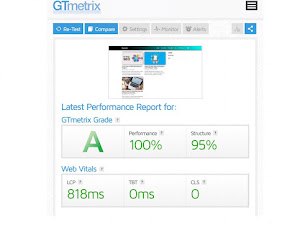How to make website load faster effective and very easy
Slow page loading or loading can be annoying and bore us. Very often, we even close and leave a page or website because we can't stand the wait for long. Delays or difficulties in loading is caused by internet connection factors or billing of the website itself.
how to make website load faster ~
When you have an internet connection, you really have to wait until normal, but if the slow load factor is caused by a website, then the owner should fix it immediately before visitors run away. For your website or blog owner, be careful with your loading speed factor as this is a very important thing.
Named for an important aspect of a blog/website, because, as the owner, you depend on your progress and success from your visitors and readers. Therefore, always do regular reviews to find out what is hampering your blog / website or potentially cause problems so that your blog performance remains stable and traffic stops down.
Why quick access is so important for websites.
The most important key to navigating the virtual world comfortably is time. Anyone on the internet would want to have a blog or website that they accessed even open in seconds. Especially when the internet connection is very fast as it is today.
Visitors don't have much time and patience to wait for pages to load in their browsers even if they want to know the content of a blog or website. Since the key to efficient and fast time is so influential here, it's best for all blog and website owners to follow the same tips and tricks.
This reason is not justified considering that Google also shares information about internet visitor data, where as many as 30% decide to leave a blog or website that reloads or load time of more than 3 seconds. Of course, this should be your main concern as a blog and website owner if you do not want to lose interest in your visitors and customers.
Tool to check the loading of the website
There are many tools or applications that you can try to find out the loading speed of a blog or website efficiently and easily. Here are 10 tools you can try:
• Google PageSpeed Insight
• Geek Flare
• Chrome DevTools
• Pingdom
• Web Page Analyzer
• GTMetrix
• Google Mobile Site Speed Test Tool
• WebPageTest
• KeyPageTest
• Loading Impact
How to Speed Up Blog Uploads or Website Blog Loading effectively and Easily
To speed up the loading of blogs and websites, many factors must support each other. Because blogs and websites are a collection and series of small to large things that are interrelated to run and function properly. Let's see how to submit below if your blog / website also has a slow loading problem.
1. Optimization of content image size
This has long been a classic problem on blogs and websites, but lately internet speed has come a long way and images or photos in content don't matter much unless the size is out of balance with the blog/website's capabilities. While the number of photos and images you can include in content doesn't really matter, just make sure they're properly optimized.
2. Expired Header/Install cache
Caching is a temporary data storage process for a blog/website's HTML content pages, intended to reduce resource consumption and server load. How it works helps speed up the loading of web pages and blogs by eliminating the need to repeatedly search for data to display the same page and increase loading speed.
To set the expiration date of a blog item, add the following code under the tag<head>
<include expiration='365d' path='*.css'></include>
<include expiration='365d' path='*.js'></include>
<include expiration='7d' path='*.gif'></include>
<include expiration='7d' path='*.jpeg'></include>
<include expiration='7d' path='*.jpg'></include>
<include expiration='7d' path='*.png'></include>
3. Limit the number of publications per page
We advise you not to display all posts on the main page, as the effect on the loading speed of your website and blog will not be that good. Logically, the more posts that appear on a page, the longer it takes to load them. Determine the number of your posts wisely.
4. Add the DNS prefecth script to the template
DNS Prefetch is a way to complete DNS queries on a particular domain. Sometimes we use external images, js, css, etc., all of which affect the loading speed of the website. By using DNS prefetch, we can reduce external link requests that take too long to load.
DNS prefetch is used to indicate the origin/source used to obtain the necessary resources and instruct the user agent, in which case the browser should prioritize loading first
To apply it to a blog, copy the following code and paste it on the head tag or code above it.
<link href='//1.bp.blogspot.com' rel='dns-prefetch'/>
<link href='//28.2bp.blogspot.com' rel='dns-prefetch'/>
<link href='//3.bp.blogspot.com' rel='dns-prefetch'/>
<link href='//4.bp.blogspot.com' rel='dns-prefetch'/>
<link href='//2.bp.blogspot.com' rel='dns-prefetch'/>
<link href='//www.blogger.com' rel='dns-prefetch'/>
<link href='//maxcdn.bootstrapcdn.com' rel='dns-prefetch'/>
<link href='//fonts.googleapis.com' rel='dns-prefetch'/>
<link href='//use.fontawesome.com' rel='dns-prefetch'/>
<link href='//ajax.googleapis.com' rel='dns-prefetch'/>
<link href='//resources.blogblog.com' rel='dns-prefetch'/>
<link href='//www.facebook.com' rel='dns-prefetch'/>
<link href='//plus.google.com' rel='dns-prefetch'/>
<link href='//twitter.com' rel='dns-prefetch'/>
<link href='//www.youtube.com' rel='dns-prefetch'/>
<link href='//feedburner.google.com' rel='dns-prefetch'/>
<link href='//www.pinterest.com' rel='dns-prefetch'/>
<link href='//www.linkedin.com' rel='dns-prefetch'/>
<link href='//feeds.feedburner.com' rel='dns-prefetch'/>
<link href='//github.com' rel='dns-prefetch'/>
<link href='//player.vimeo.com' rel='dns-prefetch'/>
<link href='//platform.twitter.com' rel='dns-prefetch'/>
<link href='//apis.google.com' rel='dns-prefetch'/>
<link href='//connect.facebook.net' rel='dns-prefetch'/>
<link href='//cdnjs.cloudflare.com' rel='dns-prefetch'/>
<link href='//www.google-analytics.com' rel='dns-prefetch'/>
<link href='//pagead2.googlesyndication.com' rel='dns-prefetch'/>
<link href='//googleads.g.doubleclick.net' rel='dns-prefetch'/>
<link href='//www.gstatic.com' rel='preconnect'/>
<link href='//www.googletagservices.com' rel='dns-prefetch'/>
<link href='//static.xx.fbcdn.net' rel='dns-prefetch'/>
<link href='//tpc.googlesyndication.com' rel='dns-prefetch'/>
<link href='//syndication.twitter.com' rel='dns-prefetch'/>5. Remove CSS JS package for blogspot
If you do this, sometimes some standard Blogger widgets won't work properly, for example it doesn't matter, just try templates> Edit HTML and then
Change code <html ...> With <HTML>
Change code <head> With <head>Change code <b:skin> With <style type="text/css"><!-- /*<b:skin>Change code </head> With <!--<head/>></head>Add code <!-- <body><div></div>--> Above the code <body>Change code </body> With </body> <!--</body>-->Change code </html> With </HTML>6. Avoid import codes @css
Instead of using CSS @import code, you should call it with code like this <link href='url css' type='text/css'/>
7. Compress CSS
There are many online tools that you can use to compress CSS. You shouldn't do this manually if you're worried it could lead to errors, but it's entirely your choice.
You can access it here = "CSS MINIFIER". Oh yes, in addition to CSS you also need to compress JS and HTML. You can access it here = "HTML PARSE CODES"
8. Use a template that loads quickly
There are many template vendors who have optimized their template speed to 80+/100. Can't sell templates if the speed rating is 60 or less? For quick template recommendations, I recommend using viomagz, magone, or Simplify.
9. Enable GZip compression
One way to speed up loading is GZip compression, which has the function of reducing CSS, Javascript, XML, font, JSON and HTML files from websites. Not only is it fast loading, GZip compression can save server resources and hosting bandwidth. You can manually activate it through cPanel to increase the speed of your blog/website.
10. Use of embeds for video content
The existence of videos in the content can drop the bounce rate because the interest of the audience will be long to watch only. To overcome this, you should use the video embed feature to upload videos on posts that will ease the burden on hosting and speed up loading progress.
11. Take advantage of the browser cache
This feature is useful to relieve the browser of visitors who come due to browser caching, so that the visitor's browser can cache files locally to facilitate the next visit, considering that the browser used is a blog.previously / file saved from the previous website. To be able to access it, you follow step no.2
12. Determine the height of the width in the picture
In the GTMetrix test tool they provide recommendations for website owners to set the length and width in the image code <img... />, if you ignore it, it can make your score drop.
13. Don't use inframes
Inframe code should be avoided, the server actually experiences delays when you have to package the code for the appearance of other websites which means that in addition to downloading data elements on your blog page, the browser must also download on other websites used as inframes.
14. Avoid the code [document.write] in js
The purpose of this code is to display HTML ads in js. So if you use the code in js it should be separated.
15. Fix broken links
The sheer number of dead links (404 errors) on your blog causes delays in crawling bots when you ask for links that are considered errors and you receive a response to an inactive page that takes a fraction of a millisecond.
If there are many links on your website that need to be repaired immediately, The following services can identify broken links and help you fix them.
In addition loading blogs with heavy content, dead links, also reduces your website's SEO reputation, so try to fix it immediately before eliminating your page rank.
Conclusions.
From the above explanation of how to speed up the loading of blogs and websites, of course you can use it as a guide to fix bugs or things that have been affecting the performance of your blog and website that you may not know and understand.
Do not add plugins that are not needed to improve the quality of blogs and websites. You should also understand the pros and cons of a plugin before installing it to avoid a collection of useless plugins overloading the page loading rate of the blog/website.
Here you can order it wisely and immediately uninstall or remove plugins that only hinder the entire process of loading your blog/ website.































